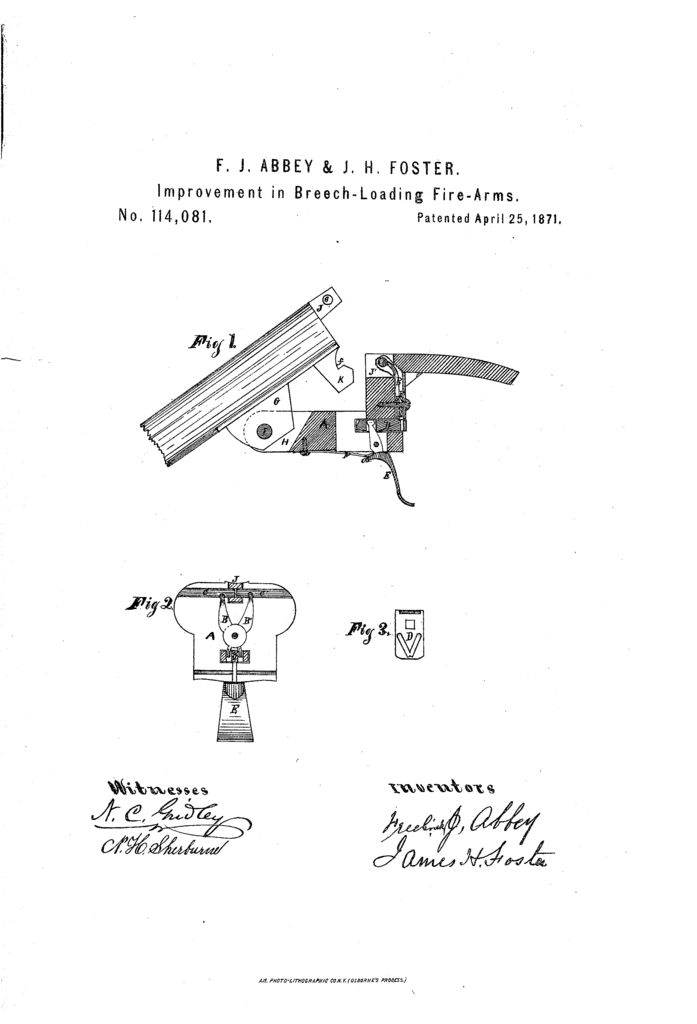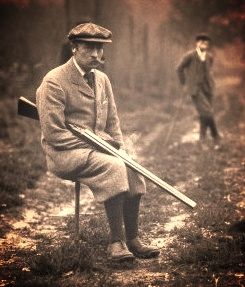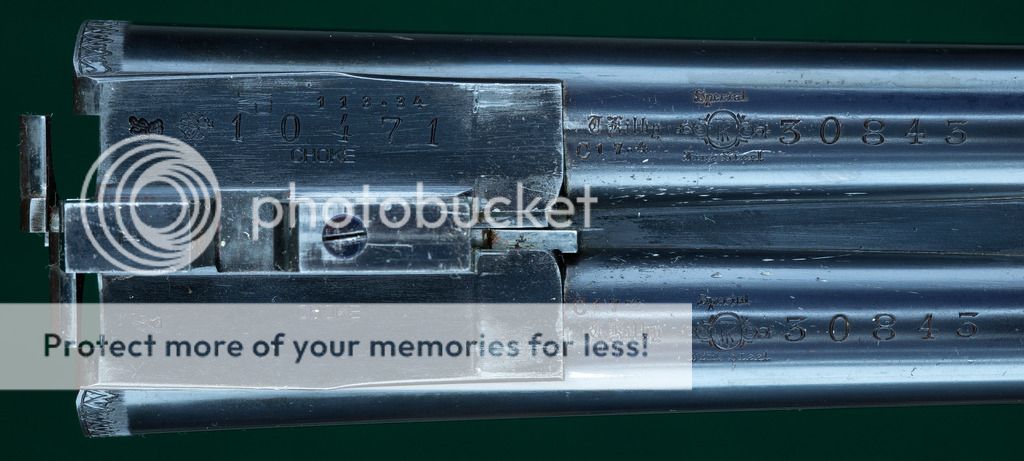|
S |
M |
T |
W |
T |
F |
S |
|
|
1
|
2
|
3
|
4
|
5
|
6
|
|
7
|
8
|
9
|
10
|
11
|
12
|
13
|
|
14
|
15
|
16
|
17
|
18
|
19
|
20
|
|
21
|
22
|
23
|
24
|
25
|
26
|
27
|
|
28
|
29
|
30
|
|
|
|
|
|
|
1 members (Marks_21),
185
guests, and
4
robots. |
|
Key:
Admin,
Global Mod,
Mod
|
|
|
Forums10
Topics38,463
Posts545,044
Members14,409
| |
Most Online1,258
Mar 29th, 2024
|
|
|
|
Joined: Mar 2013
Posts: 84
Sidelock
|

Sidelock
Joined: Mar 2013
Posts: 84 |
"Daryl" & "Eric 375," I believe the origin of your guns' "rising bite," which seems a sort of early bifurcated bolting system, as well as the mentioned Purdey-type push-forward, thumb-operated single under-bolt and 'rising-bite' release, is shown below in the ingenious F. J. Abbey (gunmaker, Chicago, Ill.) & J. H. Foster patent of 1871:  This U.S. patent was granted during the era both the subject guns were built. It also demonstrates that not all the inventiveness in the realm of firearms was concentrated overseas, but did also occur in the United States. This is a mechanical alteration that could have been performed by skilled gunmakers or gunsmiths in the U.S. to sourced action bodies (Abbey, Donn, Schafer, etc.), such as, say, the W & C Scott or Isaac Hollis hammer-gun actions sourced from Birmingham, England. The basic economic reason that even major alterations were often performed during the nineteenth century (and in to the 20th), especially those altering a gun from one ignition system to another, where one system had come successively in to general use and rapidly replaced the former system, was that even highly skilled labor was far less expensive to employ than the cost of materials. For example, if you had an action body suitable for the dated pinfire cartridge and now wanted the latest standard cartridge-firing gun instead, rather than buying a new and expensive gun built especially for the new standard cartridge, the sportsman would likely have opted to have the pinfire gun altered to use the new system. And even though the alteration would have required a lot of skilled labor time to accomplish, it was still less expensive than the materials and work on which the effort was expended. This same logic would have applied when considering upgrading or altering a costly imported action body, as would have occurred in the instant case. Regards, Edwardian

|
|
|
|
|
Joined: Oct 2011
Posts: 207 Likes: 2
Sidelock
|

Sidelock
Joined: Oct 2011
Posts: 207 Likes: 2 |
Daryl, the pins on my Abbey were a bit sticky and hard to retract. Upon removal the left one had a coil or two remaining of retracting springs. After clean up and a bit of a polish, I installed new springs and now they work nicely. The pins have a shoulder to retain the springs and were it not for cleaning I would not have noticed the remains of the retracting springs. The action flat shows patent 654 and I see that yours is marked patent 657. Wonder if they apply to the rising bite? Edwardian, is the patent shown a scissors acting type of a 3'rd bite on the barrel extension? I can see how it would work from then patent drawing. Really great just how much information is available from members on this and other sites. Without this available, they would just be another old gun in someone's collection. I really like collecting and using these wonderful firearms and the study of the different designs and patents is fascinating. So much experimentation going on in these early decades. Looks like by the late 1890's maker's pretty much settled on the designs they would use for "the modern gun" that is still being made today. Oh! The Abbey 10 bore shot nicely on the clays course today!!
|
|
|
|
|
Joined: Dec 2001
Posts: 6,269 Likes: 200
Sidelock
|

Sidelock
Joined: Dec 2001
Posts: 6,269 Likes: 200 |
Eric and Edwardian, there are a couple of things to clear up in our discussion of Abbey. The American patent for the so called rising bite is the G. T. Abbey patent 87814 of March 18, 1869. That is the patent used in G. T. Abbey #47 , and I would guess the number 657 could be a patent use number, and I would guess that it is not a use number for the patent 87814. Maybe a use number for the thumb opener, maybe not. I just think when # 46 and #47 were made, that 657 was a high use number for Patent 87814. Either way, the rising bite 87814 is about ten years ahead of the Rigby-Bissel patent 1141 of 1879 for the British rising bite patent.
Eric, I checked the firing pins on #47 and they have no springs, but they should have springs. It's just that they are missing in my gun. #47 has non rebounding locks, and a pinned forend, so must have been made in the first half of the 1870s.
I have seen guns with the closure lock of the patent 114,081, but I think not on these two guns. I have taken #47 apart and the mechanism is like Patent 87,814.
I am not sure how much the Rigby-Bissel patent relates to the G. T. Abbey patent, but I have owned a F. Beesley over under [not a shotover] that had the Rigby-Bissel locking. It looked very much, from the exterior, like the locking on #47.
By the way, Eric, what does it say on the rib extension of number 46 ?
Last edited by Daryl Hallquist; 01/02/16 10:47 PM.
|
|
|
|
|
Joined: Mar 2013
Posts: 84
Sidelock
|

Sidelock
Joined: Mar 2013
Posts: 84 |
"Eric 375," Yes, I think the scissors-like mechanism shown in the Abbey patent drawing that appears to operate the bifurcated round bolts that pass through the hole in the rib extension from either side, when combined with the single-bite depicted, do together act as a second-bite mechanically. This is an American-patented form of an early rib extension cross-bolting system. Indeed, it may have influenced other makers with whom the Abbey firm was involved, whether foreign or domestic. Below is a photograph of a (one of six known) Charles Daly 200 Grade, Diamond Quality (no black powder or nitro proof marks; undersides of barrels bear the crown-over-crossed pistols trademark of H. A. Lindner) hammer-gun with Lindner's bifurcated cross-bolting system, with each of the bolts passing through a square hole on either side of the rib extension, which in combination with the two under-bites inside the bar, where joined with the barrel lugs, act as the third-bite. This 12-bore hammer-gun was on offer with James Julia Auctioneers in October of 2015. Remark that the Lindner 'hidden' bolts shown below are rectangular in overall shape (although, I believe, square in cross section) and are not round, as are the bolts (also hidden) depicted in the Abbey patent drawing:  Daryl's knowledgeable remarks above are well worth consideration and also provide intriguing avenues for further study on the matters you have raised. Regards, Edwardian

|
|
|
|
|
Joined: Dec 2001
Posts: 6,269 Likes: 200
Sidelock
|

Sidelock
Joined: Dec 2001
Posts: 6,269 Likes: 200 |
Upon checking the British patents, I see that G. T. Abbey patented his rising bite in England with patent 2218 of July 21, 1869. It appears the same and the U.S. patent of 87814. Maybe the Use Numbers on Abbey guns 46 and 47 are for the British Patent.
I also see that E.C. Green along with F. J. Abbey and J. H. Foster had a provisional patent 929, of April 8, 1871, for the horizontal sliding bolt that is like Edwardian's fine photo above and like the U.S. patent 114,481, also shown above. British patent 2522 of Sept. 23, 1871, by the same three applicants also gives additiional Provisional Protection to this idea. Interesting to all of us is the mix of Shoverling and Daly [Gales, too]and how they related to German and British efforts sold in the U.S. through S D and G.
|
|
|
|
|
Joined: Oct 2011
Posts: 207 Likes: 2
Sidelock
|

Sidelock
Joined: Oct 2011
Posts: 207 Likes: 2 |
Daryl, there are no markings on the barrel extension of George T. Abbey #46. Only markings are: George T. Abbey on the lock plates and "George T. Abbey, Chicago. Fine Laminated Steel" on the rib, Kilby stamped in block letters on the barrels. #46 and #47 use Abbey's patent rising bite #87814 (U.S.) and #2218 (England). Birmingham view and proof marks. No evidence of Lindner influence. Possibly assembled by Thomas Kilby from action sourced from W&C Scott or I Hollis & Son's, with a nod towards W&C Scott. Date: 1869 to 1872. I checked my Boss using the Purdey bolt and 2'nd patent thumb lever. There are no patent usage markings on the action flats. If #46 and #47 patent marks refer to the use of a Purdey patent, it does not show up on the Boss made approximately the same time period. If not a Purdey patent usage mark, still a interesting bit to explore. Have really enjoyed our discussion so far. Very interesting nice old guns.
|
|
|
|
|
Joined: Dec 2001
Posts: 6,269 Likes: 200
Sidelock
|

Sidelock
Joined: Dec 2001
Posts: 6,269 Likes: 200 |
Eric, if you go to Kirby's website and then go to the Abbey #46, in the small picture icons, the eighth picture from the left shows the top of the receiver , gun open, and pointing toward you. If you click on that picture, enlarging it, there seems to be lettering on the breech end of the top rib extension. I cannot make it out and cannot copy it to another more useable photo source. The lettering appears to be in two lines.
As to the Patent Use Numbers that we see on #46 and #47, I suspect those numbers refer to the British Patent 2218, of July 21, 1869 for the Abbey rising bite. That would make sense, since the Abbey patent was probably used on other British guns, that were probably made by Scott. As an aside, I cannot recall a Patent Use Number on guns for an American patent.
Yes, these guns are interesting. I note, too, that the G T Abbey rising bite patents are illustrated with a Purdey type thumb push opener. I took my gun apart and the mechanism was simpler than expected.
Later,,as I work with Kirby's picture more and expanding it to 400% on my screen, the lettering on the top row appears to be
"Geo. T. Abbey's",, and the bottom row appears to be "Patent".
Last edited by Daryl Hallquist; 01/03/16 04:45 PM.
|
|
|
|
|
Joined: Oct 2011
Posts: 207 Likes: 2
Sidelock
|

Sidelock
Joined: Oct 2011
Posts: 207 Likes: 2 |
You are correct! My excuse for not noticing that marking is that I am woefully poor in the vision department. Looked like part of the engraving pattern until I removed my glasses and stuck my nose on the extension! Your reasoning sounds entirely logical to me. Under levers, side levers, top levers, all interesting but I really like the Purdey thumb lever openers!! So elegant in operation and execution. I can see why the top levers won out when combined with ejectors during the Edwardian era of large driven game shoots. They are probably the quickest to reload when in a tight corner. Edwardian, I can see where the light 10's would be perfect for a pheasant drive. For a full day in the field, the 6.5 pound 12 bore game guns are really ideal and even they get a bit heavy by the end of the day!
|
|
|
|
|
Joined: Dec 2001
Posts: 6,269 Likes: 200
Sidelock
|

Sidelock
Joined: Dec 2001
Posts: 6,269 Likes: 200 |
Eric, I think the thumb push is beautiful and I have a couple of guns with that mechanism. But , I have large hands and my push levers are not built for large thumbs, so they are a bit painful to me. I suppose the top lever was easier to use with gloves, too.
Good on the top rib letter mystery. I would love to know where all of the gun parts traveled before being handed to the buyer. Lovely guns.
|
|
|
|
|
Joined: Aug 2007
Posts: 10,784 Likes: 185
Sidelock
|

Sidelock
Joined: Aug 2007
Posts: 10,784 Likes: 185 |
Not a pattern welded tubeset, but a tubeset by T. Kilby Special Fine Steel, wearing Birmingham touchmarks, sourced by Springer in 1934, or something on-hand used by Springer.  T Kilby Tubeset Nr. 30845 Have we a running serialization list of T. Kilby's tubesets? Cheers, Raimey rse
|
|
|
|
|